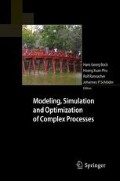Abstract
Recently we proposed a domain decomposition method (DDM) for solving a Dirichlet problem for a second order elliptic equation, where differently from other DDMs, the value of the normal derivative on an interface is updated from iteration to iteration. In this paper we develop a method for solving strongly mixed boundary value problems (BVPs), where boundary conditions are of different type on different sides of a rectangle and the transmission of boundary conditions occurs not only in vertices but also in one or several inner points of a side of the rectangle. Such mixed problems often arise in mechanics and physics. Our method reduces these strongly mixed BVPs to sequences of weakly mixed problems for the Poisson equation in the sense that on each side of the rectangle there is given only one type of boundary condition, which are easily solved by a program package, constructed recently by Vu (see [13]). The detailed investigation of the convergence of the method for a model problem is carried out. After that the method is applied to a problem of semiconductors. The convergence of the method is proved and numerical experiments confirm the efficiency of the method.
Access this chapter
Tax calculation will be finalised at checkout
Purchases are for personal use only
Preview
Unable to display preview. Download preview PDF.
References
Arad M., Yosibash Z., Ben-Dor G., Yakhot A., Computing flux intensity factors by a boundary method for elliptic equations with singularities, Communications in Numerical Methods in Engineering, 14 (1998) 657–670.
Dang Q. A, Iterative method for solving strongly mixed boundary value problem, Proceedings of the First National Workshop on Fundamental and Applied Researches in Information Technology, Publ. House “Science and Technology”, Ha Noi, 2004.
Dang Q. A and Vu V.Q., A domain decomposition method for solving an elliptic boundary value problem, In: L. H. Son, W. Tutschke, S. Jain (eds.), Methods of Complex and Clifford Analysis (Proceedings of ICAM Hanoi 2004), SAS International Publications, Delhi, 2006, 309–319.
Dang Q. A, Vu V.Q., Experimental study of a domain decomposition method for mixed boundary value problems in domains of complex geometry, J. of Comp. Sci. and Cyber., 21(3) (2005) 216–229.
Georgiou G.C., Olson L., Smyrlis Y.S., A singular function boundary integral method for the Laplace equation, Communications in Numerical Methods in Engineering 12(2) (1996), 127–134.
Mandal N., Advances in dual integral equations, Chapman & Hall, 1999.
Samarskii A.A., The Theory of Difference Schemes, New York, Marcel Dekker, 2001.
Vabishchevich P.N., Iterative reduction of mixed boundary value problem to the Dirichlet problem, Differential Equations 25(7) (1989) 1177–1183 (Russian).
Blokhin A.M., Ibragimova A.S., Krasnikov N.Y., On a variant of the method of lines for the Poisson equation, Comput. Technologies, 12(2) (2007), 33-42 (Russian).
Romano V., 2D simulation of a silicon MESFET with a non-parabolic hydrodynamical model based on the maximum entropy principle, J. Comput. Phys. 176 (2002) 70–92.
Savare G., Regularity and perturbation results for mixed second order elliptic problems, Commun. in partial differential equations, 22 (5 and 6), 1997, 869–899.
Snedon I., Mixed boundary value problems in potential theory. North. Hol. Pub. Amsterdam, 1966.
Vu V. Q., Results of application of algorithm for reducing computational amount in the solution of mixed elliptic boundary value problems, Proceedings of the National symposium “Development of tools of informatics for the help of teaching, researching and applying mathematics”, Hanoi, 2005, 247–256 (Vietnamese).
Author information
Authors and Affiliations
Corresponding author
Editor information
Editors and Affiliations
Rights and permissions
Copyright information
© 2012 Springer-Verlag Berlin Heidelberg
About this paper
Cite this paper
A, D.Q., Quang, V.V. (2012). A Domain Decomposition Method for Strongly Mixed Boundary Value Problems for the Poisson Equation. In: Bock, H., Hoang, X., Rannacher, R., Schlöder, J. (eds) Modeling, Simulation and Optimization of Complex Processes. Springer, Berlin, Heidelberg. https://doi.org/10.1007/978-3-642-25707-0_6
Download citation
DOI: https://doi.org/10.1007/978-3-642-25707-0_6
Published:
Publisher Name: Springer, Berlin, Heidelberg
Print ISBN: 978-3-642-25706-3
Online ISBN: 978-3-642-25707-0
eBook Packages: Mathematics and StatisticsMathematics and Statistics (R0)

